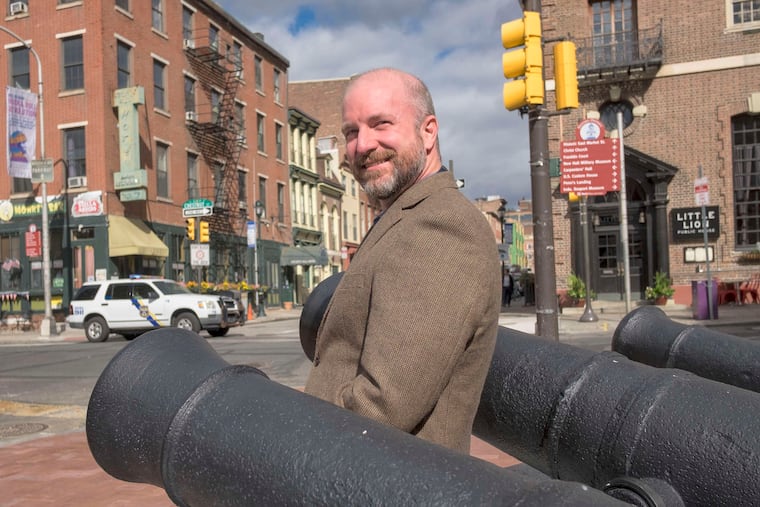Is the Declaration of Independence still relevant? | Q&A
Most of what the Declaration of Independence describes as self-evident truths, were, in 1776, far from conventional.

Philip Mead is chief historian of the Museum of the American Revolution. He has a doctorate in American history from Harvard, where he focused on early America, and has authored exhibits and other publications on the American Revolution. The Inquirer spoke to Mead for his views on how current events may provide a new lens into the history and meaning of the Declaration of Independence.
Is the Declaration of Independence relevant today? We haven’t achieved equality, so should we consider it a failed document?
I think it was an aspirational document, at least in those first five paragraphs. Most of what the Declaration describes as self-evident truths were, in 1776, far from conventional. Jefferson’s language was derivative of contemporary Enlightenment philosophy. However, the idea of equality that the Declaration laid out cut so deeply against the contemporary norms of a hierarchical society, that at the time, philosophers mocked it as a vacuous and meaningless set of platitudes that could never be applied.
The continuing relevance of the Declaration is as an aspiration. This is a noble, ongoing, and unfulfilled effort to expand the reach of its ideals and implement them in the real world.
And it has had worldwide implications. David Armitage wrote a global history of the Declaration of Independence which documents over 100 statements of independent sovereignty from all over the world that have been made since 1776 which adopt the language and concepts from our Declaration of Independence. And 31 of those international declarations have been made since 1989. It continues to be a relevant document to our international conversation and activism over equality.
How do we connect the Declaration of Independence to our lives today, and to the turmoil we’re experiencing?
We tend to think of documents as fixed in time and being sacrosanct that way. But the Revolutionary generation understood the Declaration as an ongoing conversation. John Trumbull’s famous painting of the signing of the Declaration is actually showing a delivery of the draft of the document to Congress. What Trumbull is memorializing is the beginning of the conversation, not the end. Because we are supposed to have a government based on deliberation and conversation, with all of us having a seat at the table, to arrive at better resolution than anyone of us could have figured out on our own. That’s the reading of the Declaration that Danielle Allen’s magnificent analysis of the document, Our Declaration, proposes and I think that’s what Trumbull’s painting was saying.
Did the notion of equality mean something different in the 18th century than it might now?
The world of 1776 was a hierarchical one. We tend today to imagine back into history our own attitudes about equality … that everyone has always believed equality is the right goal. But many people in the18th century thought the only way you could keep a society together and have law and order was by having a king. Monarchy didn’t just mean one person above everyone else, but a great chain of inequality, down to nobility, to gentry, to yeoman, and finally enslaved people who didn’t even have possession of their physical bodies. That hierarchal world is the one that many in the Revolutionary Generation grew up thinking as inevitable. They then make this statement as grounds for rebellion, grounded in natural rights and that immediately challenged that whole system.
At the same time, the hundreds of thousands of enslaved people did not need the Declaration to fight against their enslavement -- there were numerous uprisings of enslaved people during the 1600s and 1700s. You did have some enslaved and free people of color deploying the Revolutionary rights language in their ongoing fight against slavery, like Elizabeth “Mumbet” Freeman, an enslaved woman in Massachusetts who sued for her freedom on the grounds that the state’s new constitution recognized the natural rights of all inhabitants. Over 5,000 people of African descent served in the Continental Army to assert those same rights.
What you’re describing suggests people in 1776 were struggling with what equality and liberty meant — and right now we’re asking the same questions.
History is not linear. It’s not always progressing toward the light. It disappoints after periods of hope. There’s this hope and this bitter disappointment that the country just dug in on slavery for a long time. In 1776, there were half a million enslaved people. In 1861, there were 4 million.
This is a story that’s not just going upward. It’s not linear. It’s not, unfortunately, always arcing toward the light. It has to be made to bend that way. People have to fight for it and work and talk and come to some kind of solutions. It doesn’t just happen.
Do today’s protests give us a chance to look at this document with a different perspective, or take something new from it?
Absolutely. We continually face the question of how well we are living into the promises set forth in the Declaration. Each generation must look at itself and ask, are we making progress?
The Declaration did not immediately apply to all people. What we’re seeing today is an outgrowth of repeated failures over time to live up to its aspirations. The question is, what can we do differently this time? That’s what every new generation has to decide.